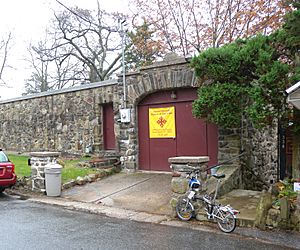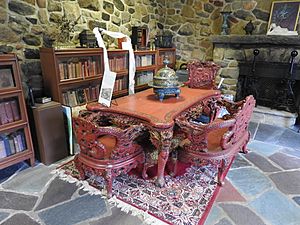Jacques Marchais Museum of Tibetan Art facts for kids
 |
|
| Established | 1947 |
|---|---|
| Location | 338 Lighthouse Ave, Staten Island, New York, United States |
The Jacques Marchais Museum of Tibetan Art is a special museum located on Lighthouse Hill in Staten Island, New York City. It holds one of the largest collections of amazing items from the Himalayas in the United States. The museum was created by an American woman named Jacques Marchais (who lived from 1887 to 1948). She wanted it to be a way to connect the Western world with the rich, old traditions and culture of Tibet and the Himalayan region.
Marchais designed her museum to feel like a real experience. It looks like a rustic Himalayan monastery with beautiful terraced gardens and a pond with fish and lotus flowers. Even the Dalai Lama praised the museum for how authentic it felt when he visited in 1991. In 2009, the museum was added to the New York State Register and National Register of Historic Places, which means it's recognized as an important historical site. A writer for the New York Times mentioned that the museum's founder was actually named Jacqueline Klauber, and Marchais was her professional name.
Who Was Jacques Marchais?
Jacques Marchais Coblentz was born in 1887 in Cincinnati, Ohio. When she was young, she worked as a child actress in Chicago. Later, she moved to New York City and continued acting. She became interested in Eastern religions and Buddhism. Around 1920, she married a chemical factory owner, and they lived in a quiet, rural part of Staten Island. This is where she began collecting many unique art pieces.
A Lifelong Dream
Marchais never actually traveled to Tibet or the Himalayas herself. However, she had a deep interest in the region throughout her life. She wanted to find a permanent home for her growing collection of artifacts. She opened an art gallery in Manhattan in 1938. Then, in 1945, she opened a research library right next to her home in Staten Island. The museum officially opened its doors in 1947, sharing her passion with the public.
Visiting the Museum
The Jacques Marchais Museum is a bit of a hidden gem among New York City's many cultural places. It doesn't have its own parking lot, which makes it harder for cars to find. However, bicycling clubs often make it a special stop because it's easier for them to park their bikes. This unique museum continues to share the beauty and history of Tibetan art with visitors.
See also
- Tibetan art
- Buddhist art
- List of museums and cultural institutions in New York City


